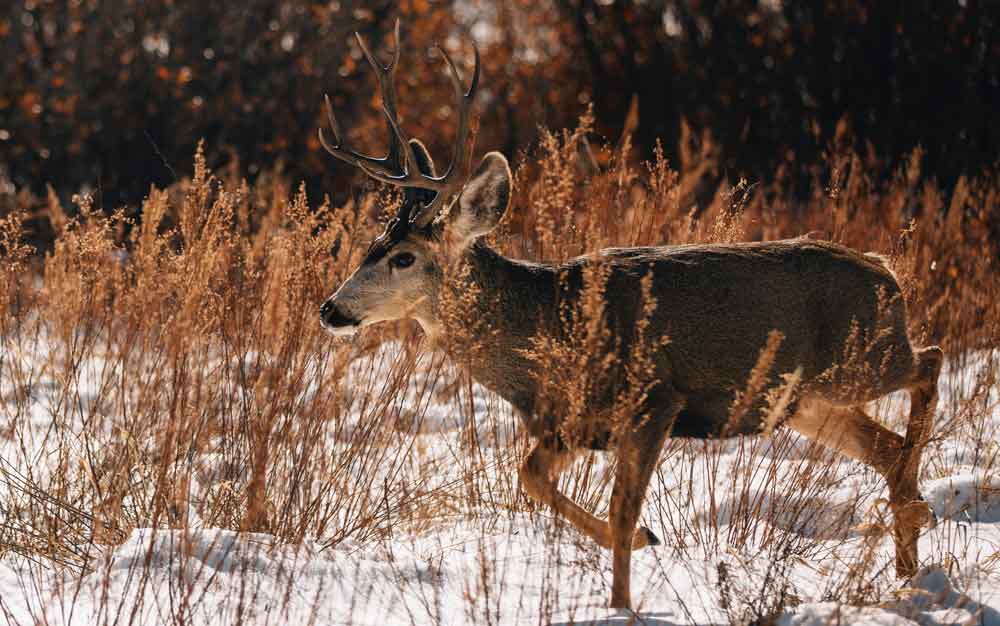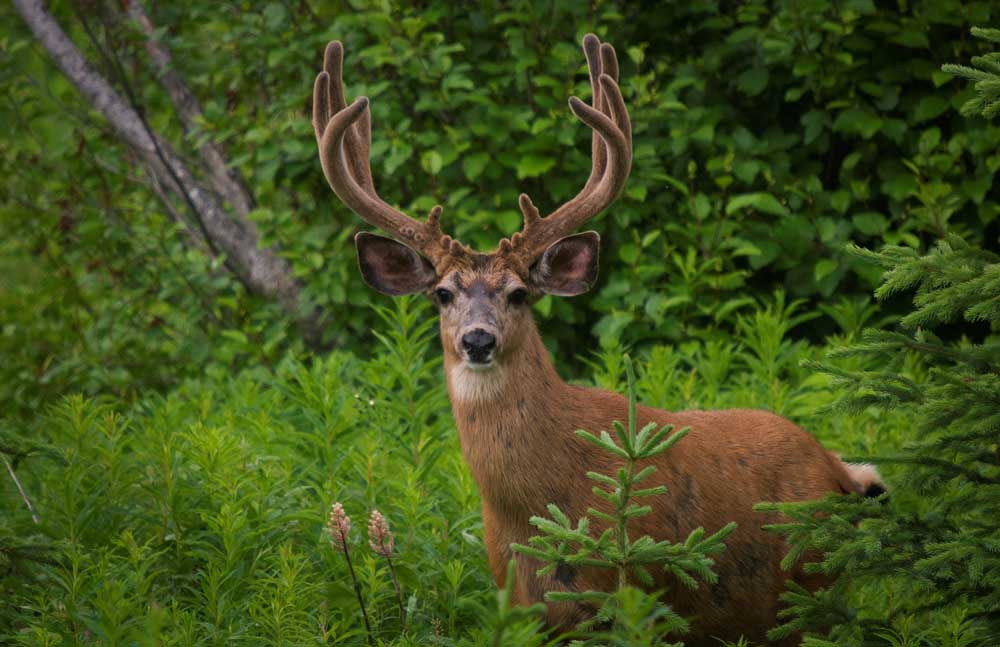Mule Deer Need Fire
Mule Deer(Scientific Name: Odocoileus hemionus)
Did you know Mule deer get their name from their large ears, resembling a mule?
Their ears serve a functional purpose, as they have exceptional hearing that helps them detect predators.
Introduction
Mule deer are a common sight in British Columbia, occupying a range of habitats including forests, grasslands, alpine areas, and urban developments. A vital part of the ecological communities they inhabit, mule deer provide food for several predators such as cougars and wolves, of which deer are a primary food source. Coyotes, bears, ravens, and wolverines will also opportunistically feed on deer to supplement their diets. Mule deer are also an important species to human communities and have been an essential component to the cultural practices, knowledge transfer, and food security of many Indigenous peoples, while also providing hunting and wildlife viewing opportunities for non-indigenous folks across the province.
Less common knowledge, however, is that mule deer have been in decline in B.C. since the 1950’s. Overharvest was originally thought to be the cause, though decades of hunting restrictions has not reversed the fate of mule deer populations. Although the exact reasons are yet to be deduced, the cumulative impacts of several factors have likely led to the decline of this once-abundant species, including forest fire suppression, large-scale timber harvesting, roadbuilding, urban sprawl, and the introduction of invasive species (BCWF 2023). Researchers, biologists, and land mangers consider mule deer a “canary in a coal mine,” the health of the species offering a glimpse into the state of the ecosystems it inhabits. Several initiatives are underway in Western Canada and the United States to pinpoint the cause of the mule deer declines, facilitate better land-use decisions, and eventually reverse the impacts on deer populations (BCWF 2023, WAFWA 2020).
Left: Tracking collars ready to be deployed and fitted on mule deer. Right: Mule deer with tracking collar. Source: Southern Interior Mule Deer Project
Fire
The B.C. landscape has seen many changes in the twentieth century, including a shift away from Indigenous fire stewardship and a move towards European fire suppression practices. While fire suppression can reduce risk to human settlements, it also dramatically changes forest structure, allowing once open forests to mature into dense, closed-canopy stages. Fire is a natural part of the landscape, and when able to burn at low or moderate intensity, it promotes renewal and regrowth. The new growth that occurs post-fire offers an abundance of nutritious forage for deer in their summer ranges, allowing populations to thrive. Additionally, newly burned areas provide a longer line of sight from which deer can more easily spot and avoid predators (Berry 2018, Brooks et al. 2021).
As climate change increases the frequency, severity, and size of forest fires, the direct and indirect impacts to mule deer populations remain largely unknown. As previously mentioned, the removal of canopy cover can improve forage availability and reduce predation risk in the summer. In the winter, however, this lack of canopy cover decreases snow interception, making it more difficult to move through these areas and avoid predators. As fire activity intensifies with climate change, the impacts will be dependent on how deer navigate the trade-offs between improved summer forage opportunities and functionally reduced winter ranges (Ganz et al., 2022).

Mule-deer doe in recently burned forest where fireweed, grasses and shrubs have regrown. Source: Animal Ecology in Focus
Habitat & Population Concerns
Like fire suppression activities, forestry practices have also transformed in the last century, favouring clear-cut forest removal that allows for efficient and economic timber harvest. The impacts of cutblocks are, correspondingly, mixed. Like new burns, young cutblocks provide canopy openings, offering a variety of forage for deer in the summer. In the winter, the lack of snow interception makes these areas difficult to navigate and provides little cover or reprieve from predators. Road development in and around forest cutblocks can also provide easy access for predators. In one study, mortality risk was shown to increase in harvested areas that also have a high road density (Wright 2023). Nonetheless, forestry and deer populations can coexist. A study conducted in the southern interior of B.C. found that the impacts of cutblocks on the landscape are not necessarily detrimental in winter ranges, provided enough mature forest exists in adjacent areas, underlining just how important the retention of old and mature forests is (D’Eon and Serrouya 2005).

Two mule deer crossing Highway 97C, between Aspen Grove and Kelowna, using wildlife overpass. Source: TranBC
Other factors affecting mule deer populations include urban sprawl, road development, and the introduction of invasive species. On average, over 10,000 km of new roads are added to the B.C. landscape every year. These roads can become barriers to the migration patterns mule deer have followed for generations. Should a migration route suddenly become blocked, deer do not have the mental plasticity to find a new route, leaving them particularly sensitive to changes on the landscape (UBCO 2019). The addition of new roads also facilitates a broader range of human movement, promoting the proliferation of invasive species, whose seeds can be carried on hikers’ shoes, vehicle tires, and equipment. Invasive species are typically aggressive spreaders, with an ability to easily outcompete native species and take over high-value habitats. This can drastically reduce the nutritional quality and availability of forage for deer populations.
British Columbians have a lot to think about when it comes to the health of mule deer and other wildlife populations. Fortunately, there are some fantastic organizations working diligently to find solutions. The Southern Interior Mule Deer Project, based out of the UBC Okanagan campus, is conducting a large-scale monitoring project to track mule deer populations in the southern interior and help answer questions regarding future management (BCWF 2023). From what they, and other organization have deduced so far, management efforts should focus on habitat corridors that allow deer to continue their annual migrations, minimizing or rehabilitating roadways to reduce predator access, and prioritizing the retention of old growth forest and native habitats that provide cover and forage. Prescribed burning practices have started to be reintroduced in some areas of B.C., offering an alternative to intensive fire suppression practices, while several Invasive Species Societies work diligently to manage the spread of noxious weeds and invasive species throughout the province (CKISS 2021, ISC n.d.). Ultimately, the health of B.C.’s mule deer populations depend on the health of the ecosystems that support them. Reversing population declines will only be achieved through a collaborative and unified effort between land managers, scientists, NGO’s, First Nations, government, and all British Columbians. Do we have what it takes?


Mule Deer Buck Photo Credit Grant Hiebert
Ecological Importance: Mule deer play a vital role in the ecosystems of British Columbia by shaping plant communities through their feeding habits and acting as prey for larger predators.
Mule deer have been in decline in B.C. since the 1950’s.
In The News
Cultural Burning & Prescribed Fire
A tool for maintaining the health and safety of our forests, communities, and wildlife.
How some wildlife can benefit from wildfires and their aftermath, according to environmentalists
Wildfire can lead to the growth of a diverse range of deciduous trees and shrubs, which can then serve as an abundant source of food for wildlife such as moose, say B.C. environmentalists. (D. Boudreault/Bonjour Québec )
CBC News
B.C. policy-makers urged to embrace controlled burns to reduce wildfire risk
Fire ecologists and some First Nations say prescribed and cultural burns will help reduce B.C.’s fuel load
CBC News
Wildfires cause havoc for humans, but not mule deer
SAANICH NEWS
While fires cause havoc for humans, our wild neighbours adapt easily.

Chloe Wright, PhD Student
Department of Biology University of British Columbia – Okanagan Campus

Photo Source: SIM Deer Project
DEER DATA
IMAGES OF SURGING SUMMER WILDFIRES AND SMOKE-FILLED SKIES ARE STILL FRESH in the memories of British Columbians.
UBC
MORE INFORMATION
More information of mule deer and mule deer initiatives in B.C.:
- Southern Interior Mule Deer Project – website
- Community for the Wild – video
- Western Association of Fish & Wildlife Agencies, Mule Deer Working Group – website
- Government of B.C., Mule Deer Management Plan – document
- Government of B.C., Mule and Black-tailed Deer in British Columbia – document
References:
[BCWF 2023] BC Wildlife Federation. 2023. The Southern Interior Mule Deer & Cougar Projects. Retrieved from https://bcwf.bc.ca/initiatives/mule-deer-project/
Berry, C. 2018. Wildfires cause havoc for humans, but not mule deer. Saanich News. Retrieved from https://www.saanichnews.com/news/wildfires-cause-havoc-for-humans-but-not-mule-deer-256373
Brooks, W., Daniels, L., Copes-Gerbitz, K., Baron, J., and A. Carrol. 2021. A Disrupted Historical Fire Regime in Central British Columbia. Frontiers Ecology and Evolution 9, 1-14.
[CKISS 2021] Central Kootenay Invasive Species Society. 2021. Retrieved from https://ckiss.ca/
D’Eon R. and R. Serrouya. 2005. Mule Deer Seasonal Movements and Multiscale Resource Selection using Global Positioning System Radiotelemetry. Journal of Mammalogy 86(4), 736-744.
Ganz, T., DeVivo, M., Kertson, B., Roussin, T., Satterfield, L., Wirsing, A., and L. Prugh. 2022. Interactive effects of wildfires, season and predator activity shape mule deer movements. Journal of Animal Ecology 9(11), 2273-2288.
[ISC n.d.] Invasive Species Council of BC. n.d. Retrieved from https://bcinvasives.ca/
[WAFWA 2020] Western Association of Fish & Wildlife Agencies. 2020. Mule Deer Working Group. Retrieved from https://wafwa.org/committees-working-groups/mule-deer-working-group/
Wright, C., 2023. SIMDeer: How habitat use impacts mule deer survival in south central BC. BC Wildlife Federation. Retrieved from https://www.youtube.com/watch?v=XXF200jNB_w
[UBCO 2019] UBC Okanagan. 2019. Deer Data. Retrieved from https://news.ok.ubc.ca/2019/09/20/deer-data/
